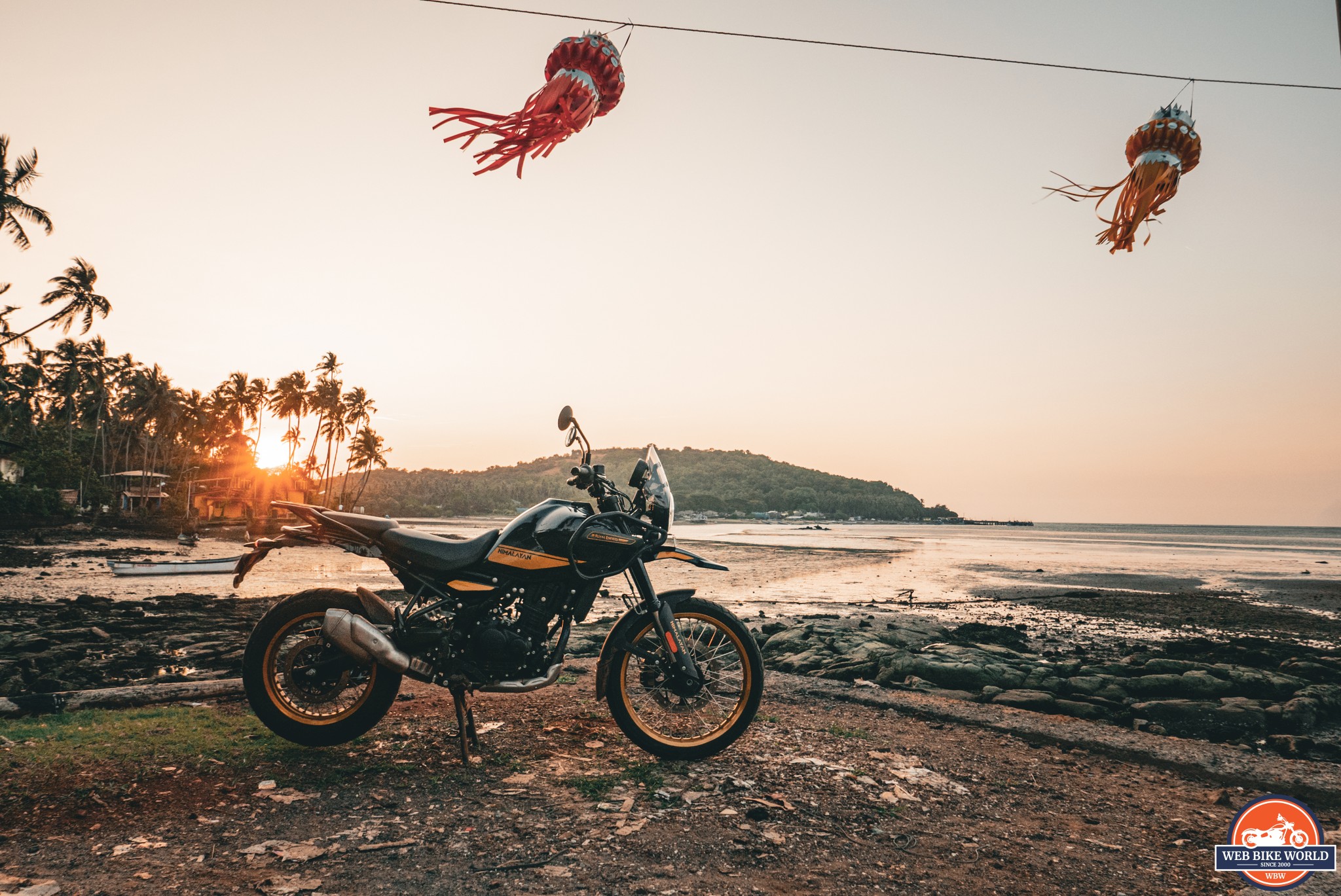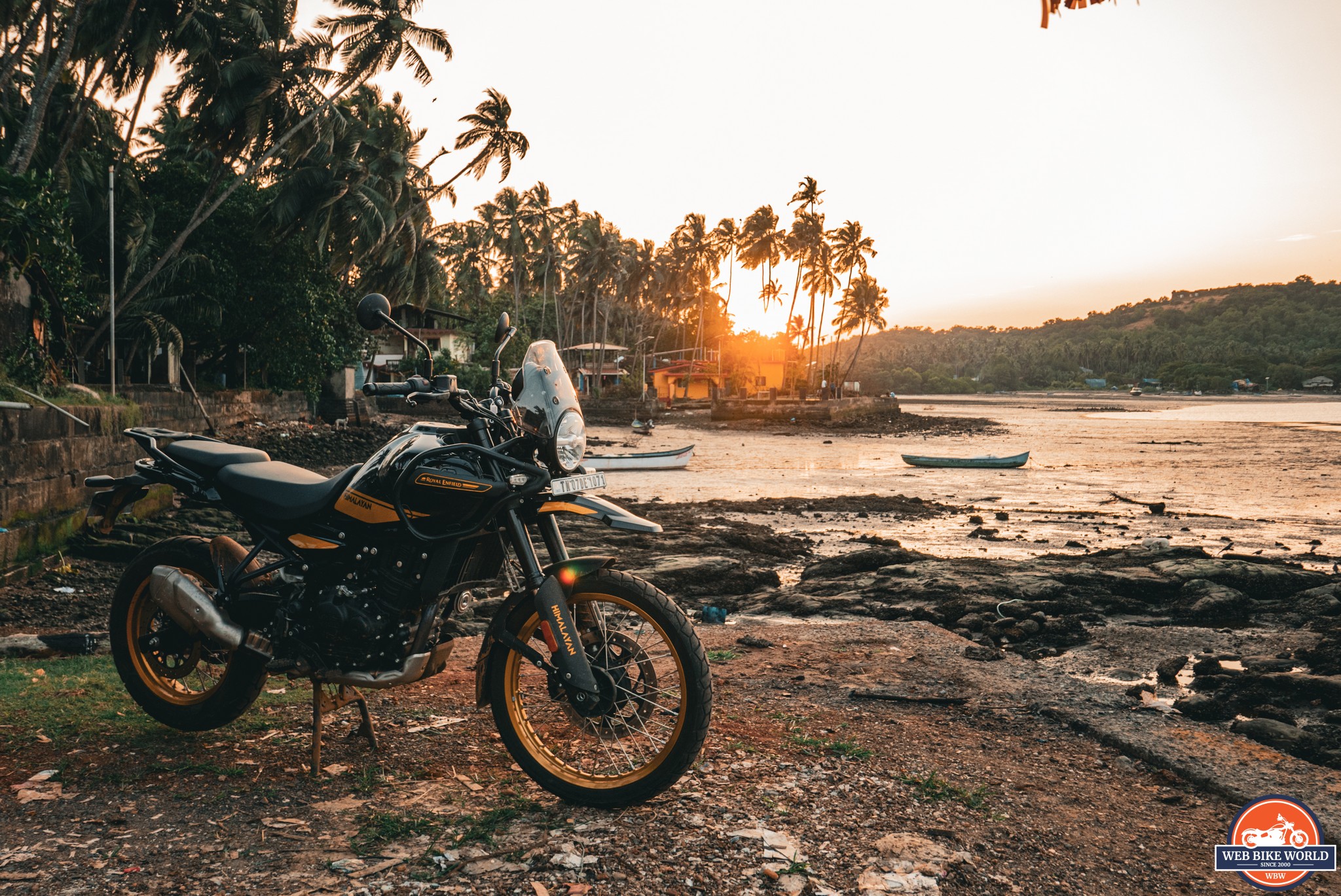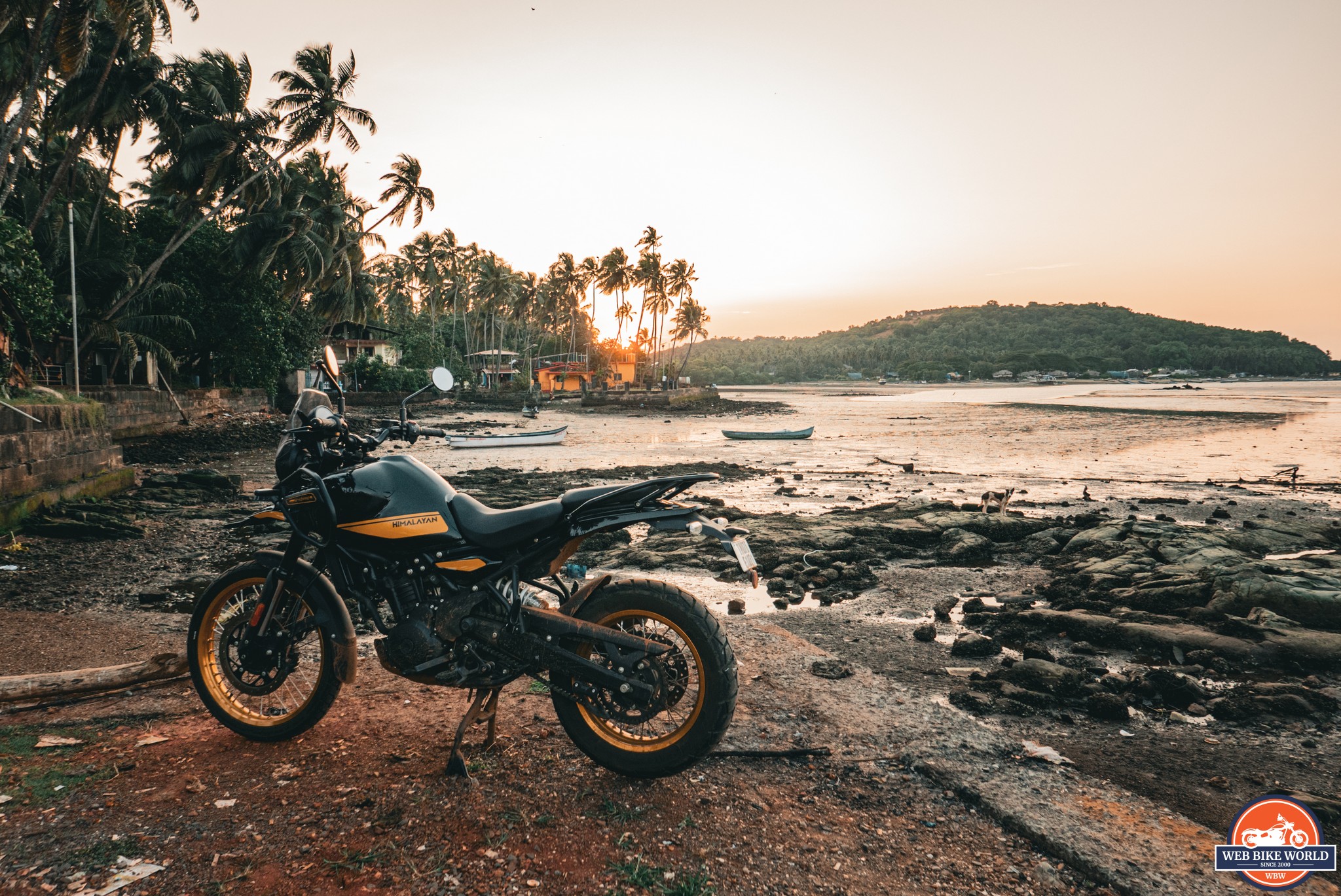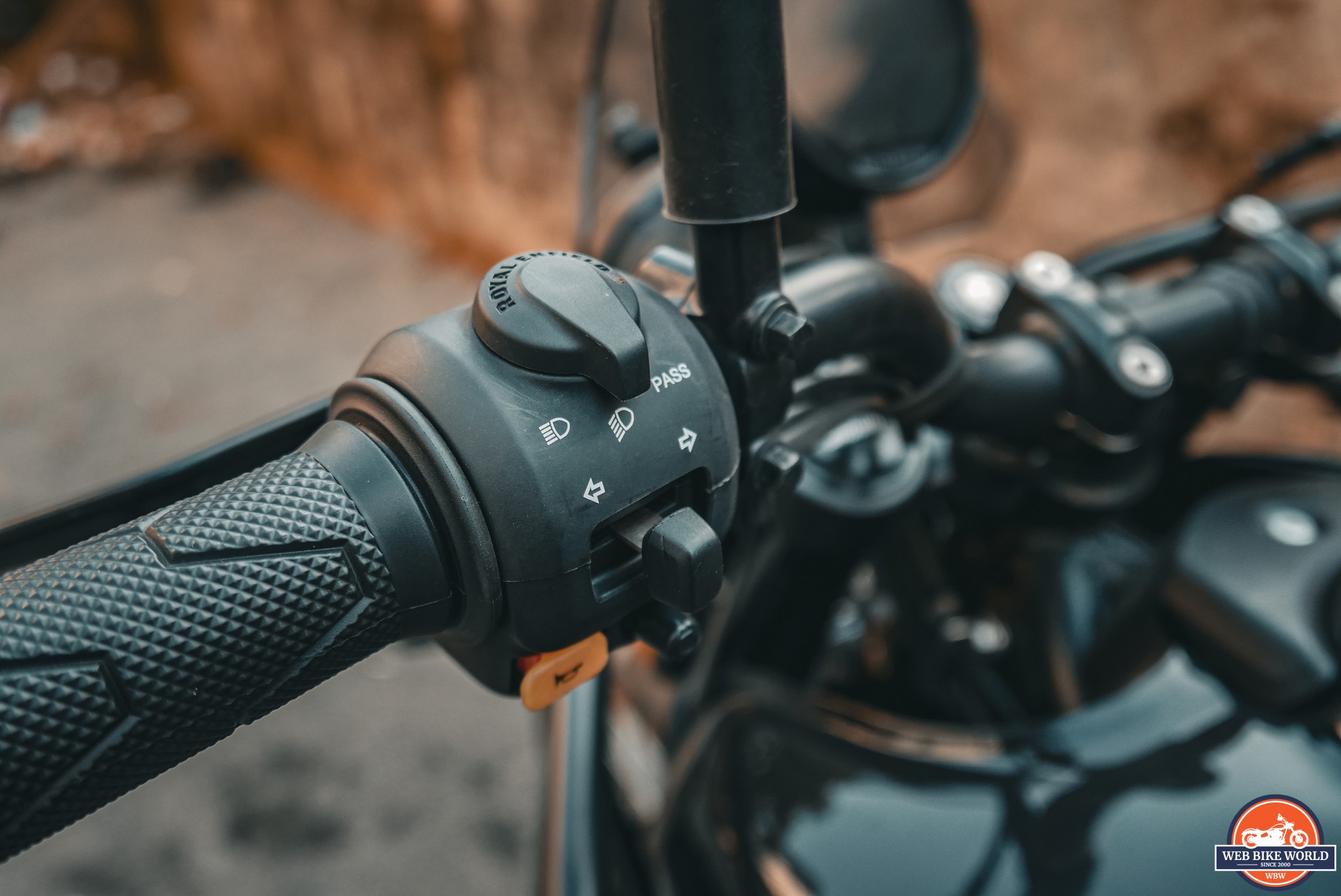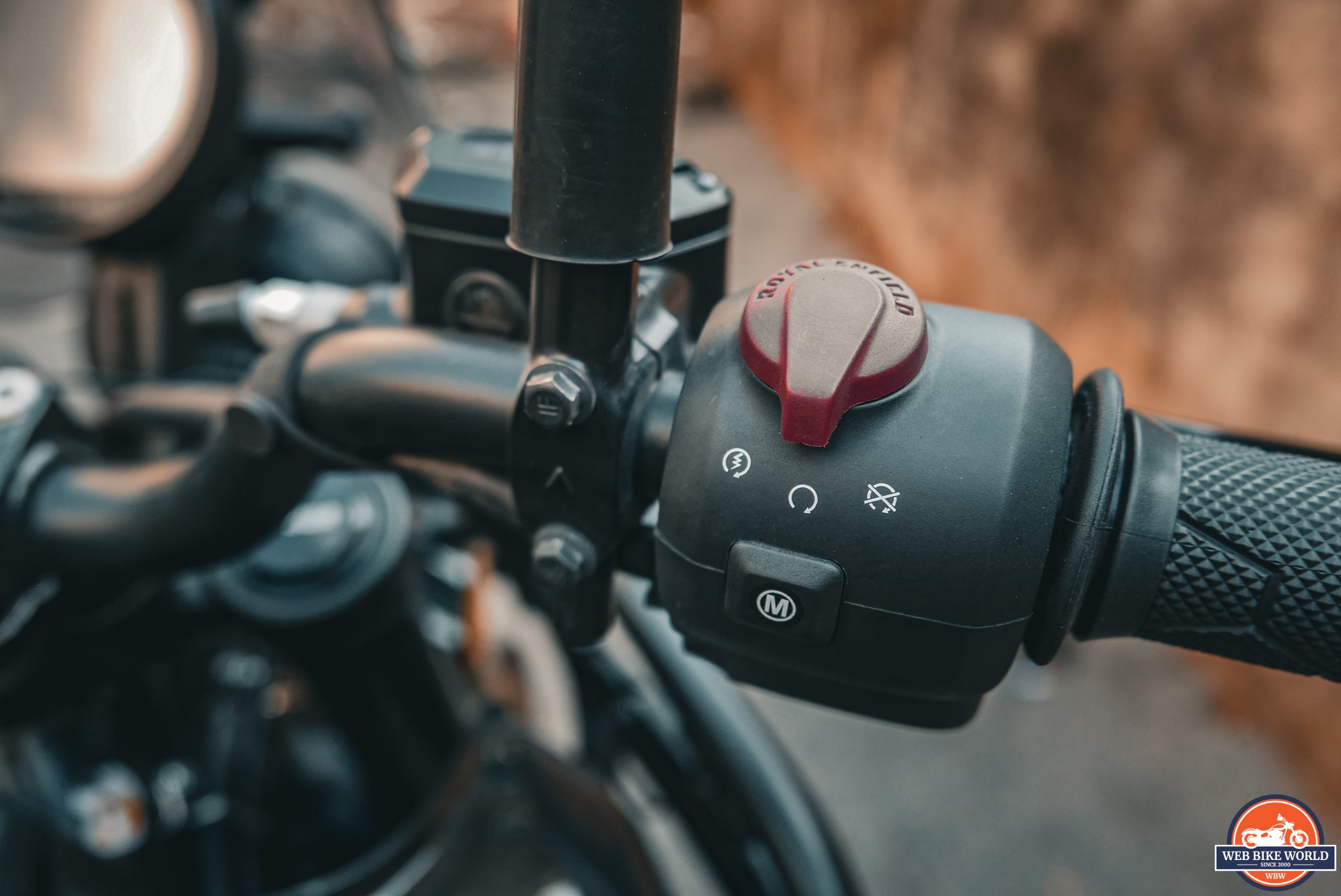 Specs At A Glance
Specs At A Glance
- New water-cooled 452cc single-cylinder engine
- 181kg dry / 198kg wet
- 2 riding modes and switchable rear ABS
- Premium electrics and lighting
- A capable adventurer and competent commuter
- Feels heavy but rides light
- All new modern styling
- Great value at an estimated USD $6500
Good Times In Goa
Thanks to the folks at Royal Enfield I recently found myself in the west Indian state of Goa for the brand’s annual Motoverse festival. The event is a 3-day celebration of the Royal Enfield brand with everything from dirt racing events to live music on a huge main stage. Motoverse attracts crowds of over 20,000 people and they arrive from all over the country, many of them choosing to ride to the show on their own Royal Enfields.
I was at Motoverse as a special guest with around 30 other international visitors. We were invited there to take in the sights and sounds of the event and to take part in live Q&A sessions.
Seeing as the last time I was in India was 15 years ago, I decided to extend my stay in Goa a few days after the show. As it turned out some of my fellow guests had the same idea. So one night over beers, a group of us hatched a plan to get our hands on some Himalayan 450s and head off on an overnight adventure.
Surprisingly, it took very little effort to convince the Enfield team to hand over the bikes, and our plan was set in motion.
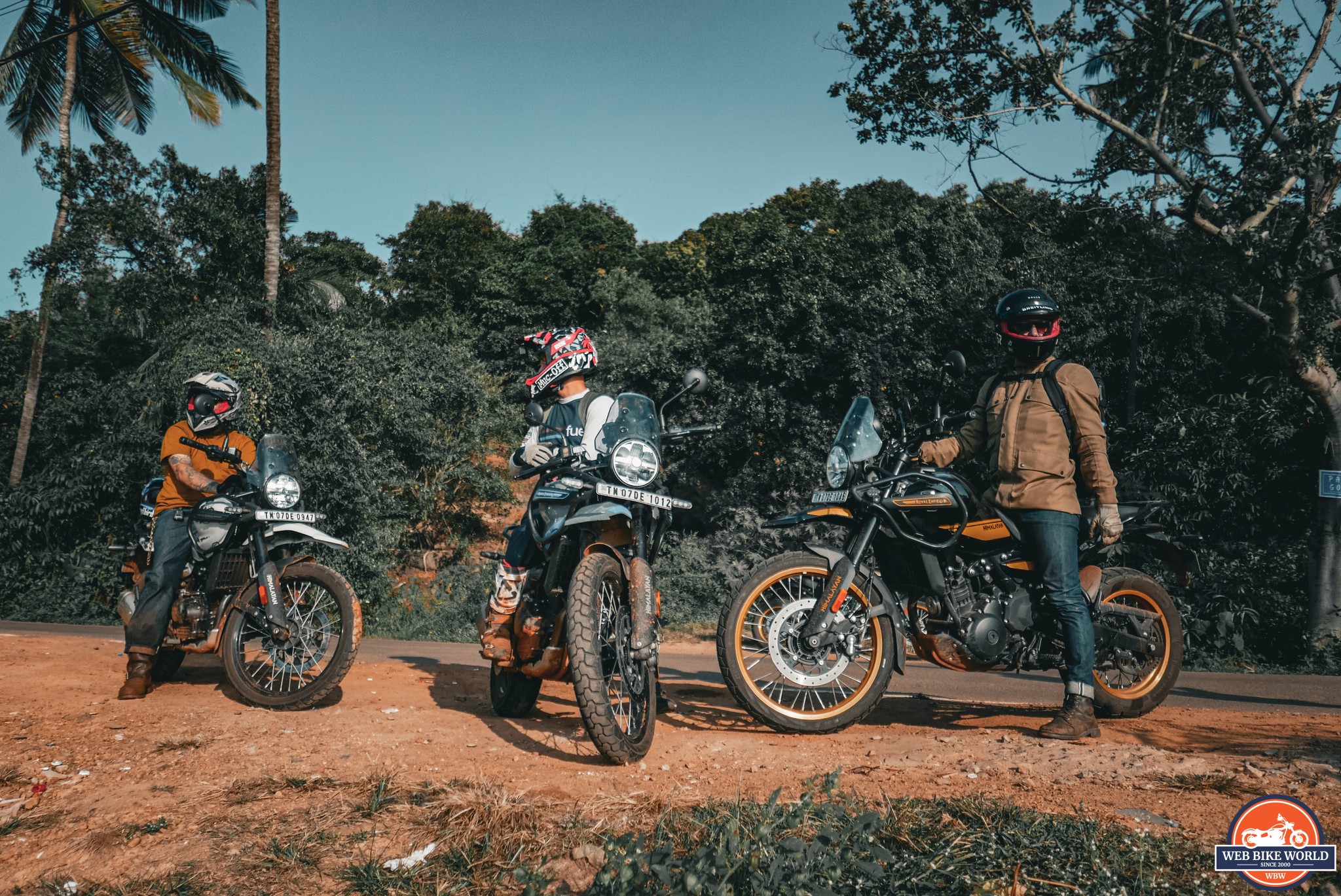
The day after the show we met for breakfast to plan a route. I was accompanied by custom bike builder Christian Sosa of Sosa Metalworks in Las Vegas. Adventurer and founder of UK riding gear brand Malle London, Robert Nightingale. And German action sports star and TV host Niels Peter Jensen.
We planned to head northeast from Vagator to the highest peak in Tilari Nagar along the windiest stretch of road we could find. From there we would head to Belgavi, a city in the neighboring state of Karnataka, to find accommodation for the night. The following day we would head southwest passing through an elephant and tiger reserve where we were told the roads were particularly challenging.
With our caffeine quota met and a solid plan in place we set off to collect our Himalayan 450s from a nearby hotel.
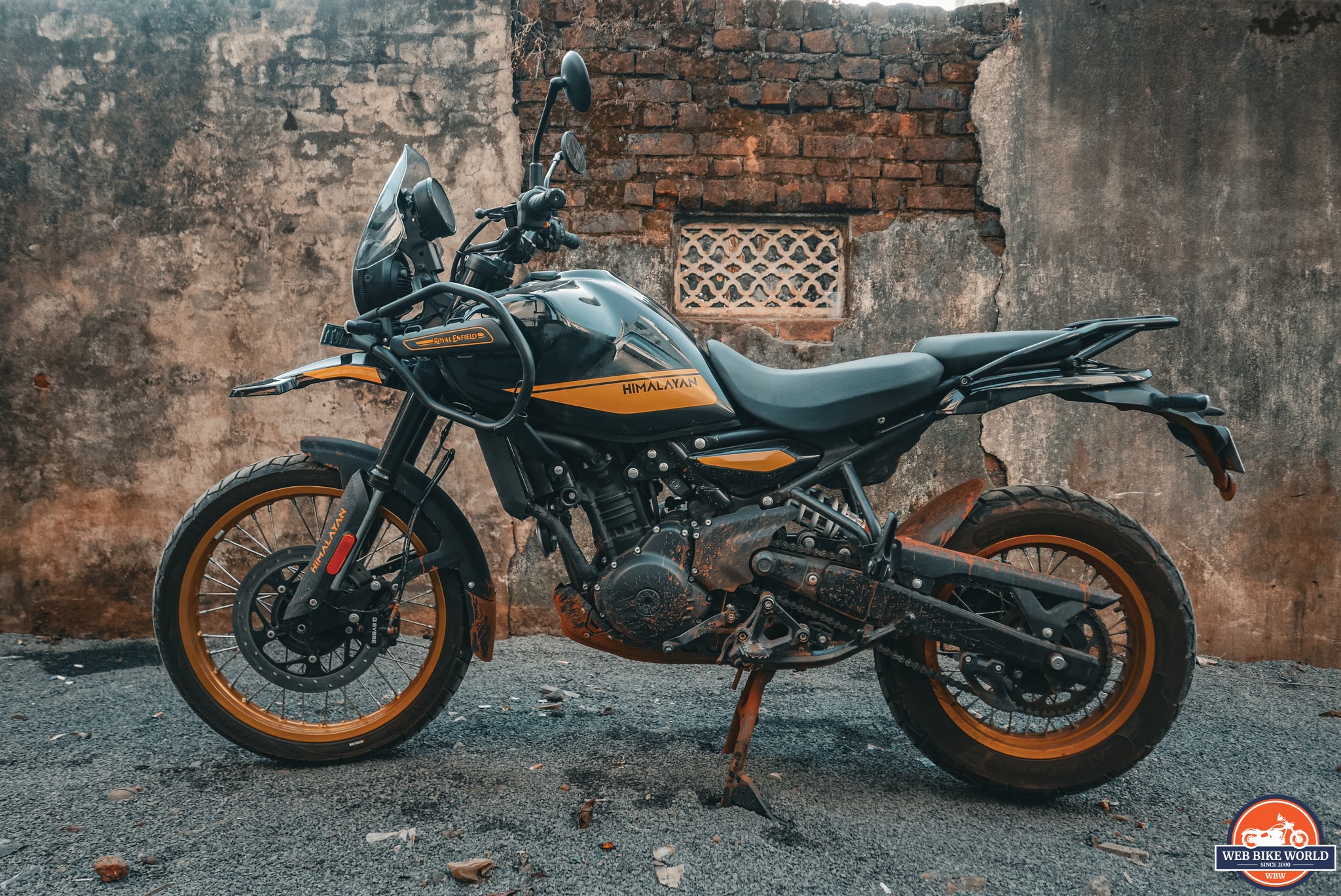
First Impressions
When we arrived to pick up our Himalayan 450s I already had my heart set on the Hanle Black edition. Of all of the 5 different colorways, which Enfield says were inspired by the colors and textures of the Himalayan mountains, it was by far my favorite.
The sleek black and gold scheme is reminiscent of the John Player Lotus F1 I loved so much as a kid. The paintwork was smooth and the finish on all of the graphics was top-notch.
The bikes we were given had already been subjected to significant punishment. During Motoverse, showgoers had the option to test ride the Himalayan 450 and our bikes had been part of that fleet.
Since there was no real screening aside from proof of license, many of the bikes had been dropped during the event. Three of our four bikes showed evidence of this in the form of bent levers of scratched exhausts. Despite that, they were all still in good working order and a bit of cosmetic damage certainly wouldn’t ruin our fun.
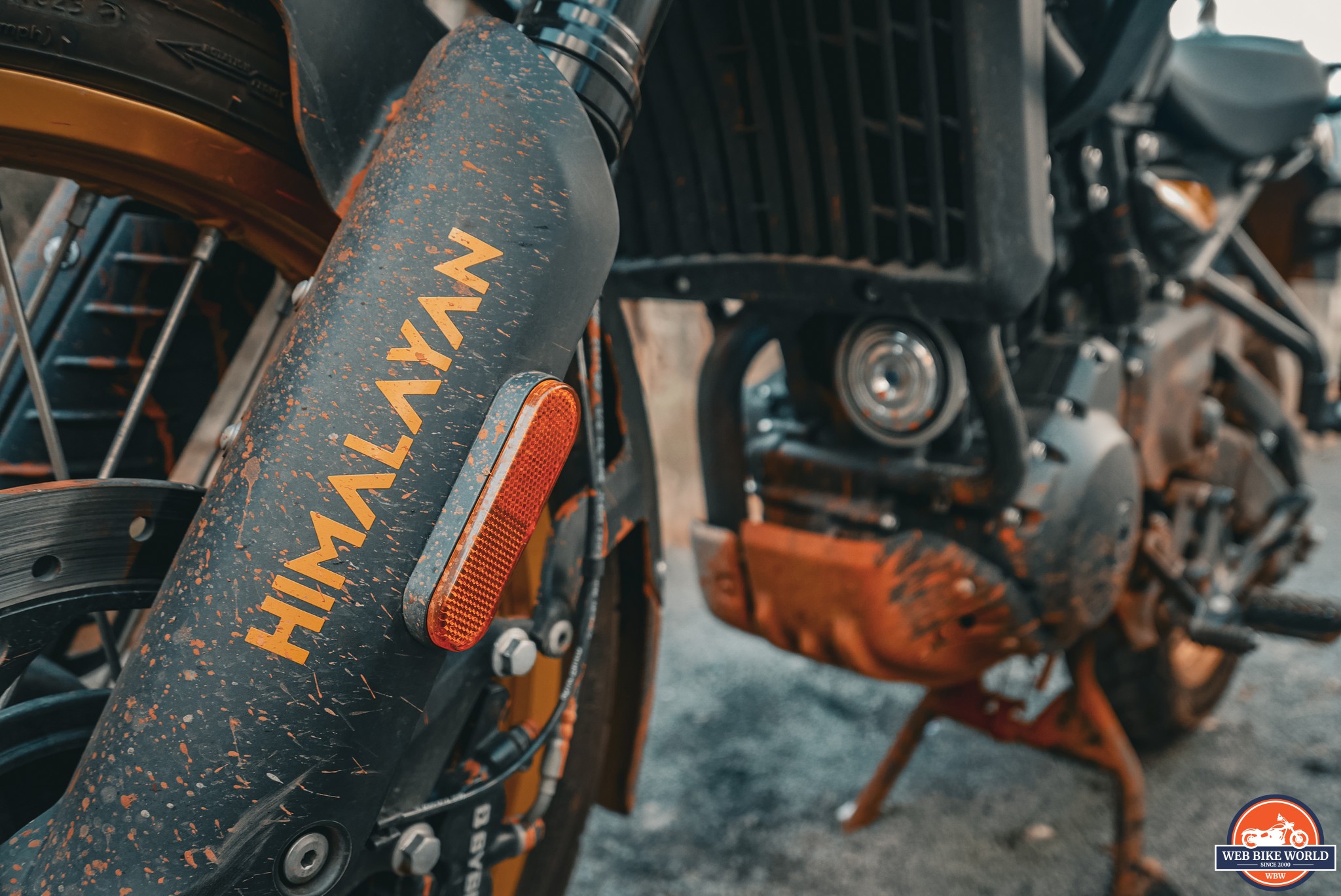
When I sat on the bike I was immediately surprised by its weight. It felt heavy and a lot of the weight seemed to be up high due to the full 17-litre fuel tank. Aside from that initial shock, everything else made sense.
The controls were all well positioned, my hands sat comfortably on the wide bars and the broad seat was a good fit for my average-sized derrière. The large 4-inch TFT screen in front of me looked premium and that feeling of quality continued as I looked over the rest of the bike.
Stepping off the Himalayan I had a chance to take a closer look at the Sherpa 450, Enfield’s all-new water-cooled single-cylinder engine. Angled forward in the chassis the engine appears unfussy and the all-black finish helps to beef up its appearance. The modestly sized radiator sits at the front of the engine covered by a louvered plastic guard.
It’s mounted high on the frame just below the bottom of the triple clamp out of harm’s way. This places it out of your main line of sight so its presence doesn’t detract from the overall look.
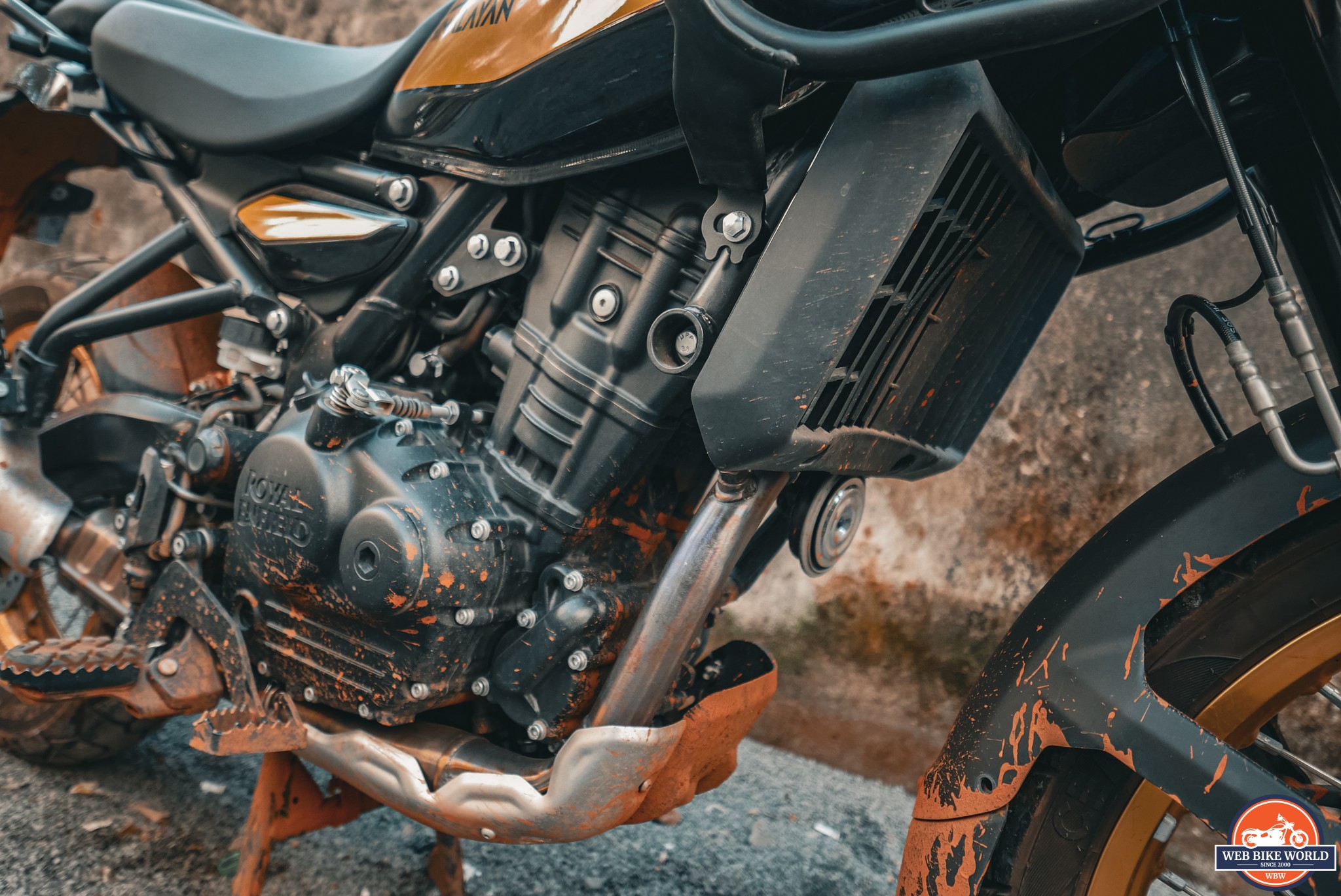
Perhaps the most striking thing about the 2024 Himalayan 450 is its styling. Unlike the hard-edged utilitarian appearance of the outgoing model, this Himalayan is decidedly modern-looking.
In fact, it looks exactly how you expect a modern adventure bike to look. For some reason, Royal Enfield opted to move away from the angular, almost military styling of the previous model and replaced it with a smooth, somewhat bulbous fuel tank. To be honest, it didn’t win me over straight away, but by the end of the trip I was a convert.
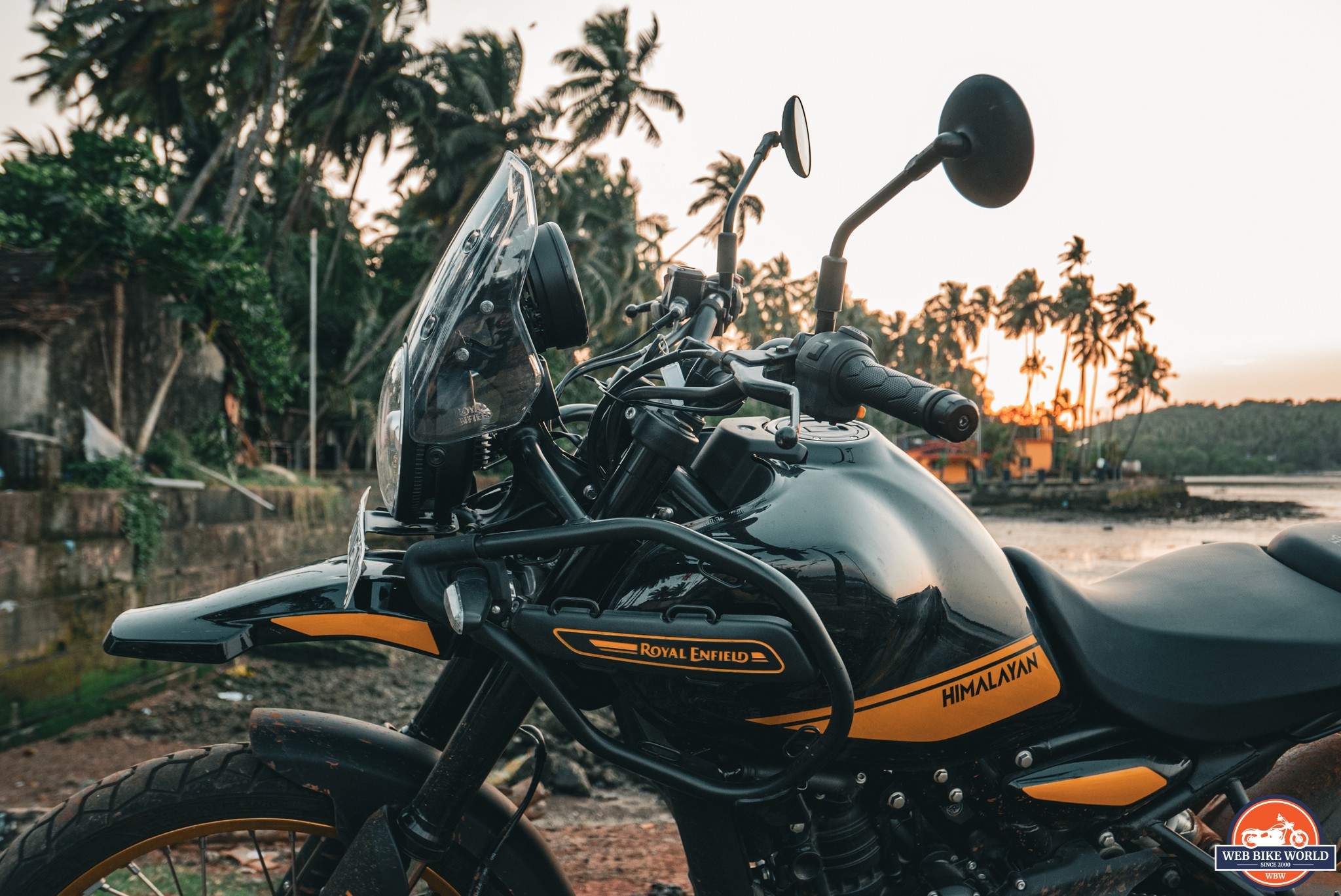
Value For Money
Before going into the full list of Himalayan 450 specifications and accessories I will say that based on price alone, this motorcycle is going to be hard to beat in the adventure bike segment.
Judging by local pricing this new model is likely to cost between $6,500 and $7,200 when it lands in the US. Although that’s a significant increase over the previous model, what you’re getting for that extra money outweighs the extra cost.
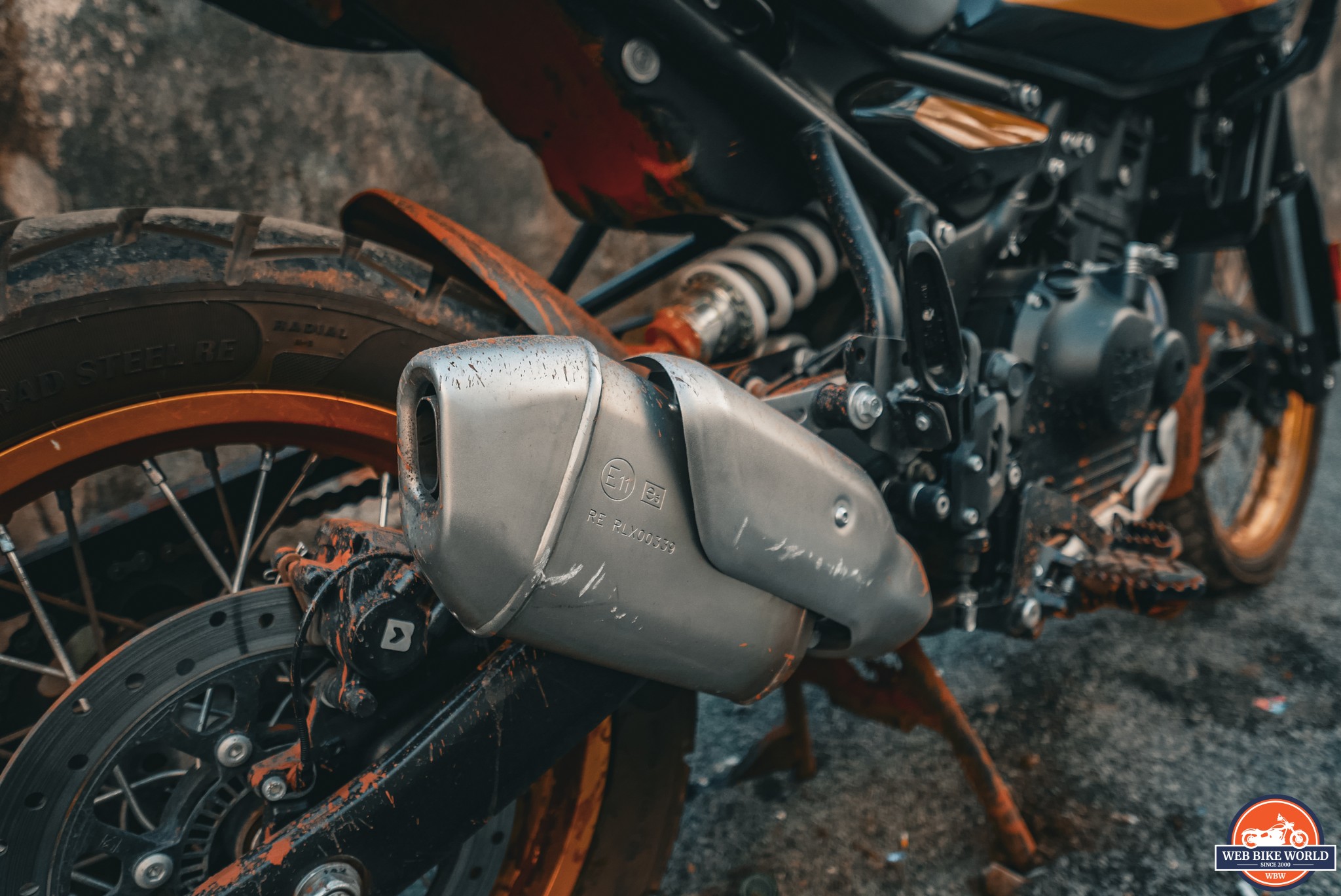
The Sherpa 450 Engine
The 2024 Himalayan is powered by the Sherpa 450 liquid-cooled, 452cc DOHC, 4 valve single cylinder engine. It’s an all-new design for Royal Enfield and their first entry into water-cooled technology, a move that is essential for the brand’s future due to ever-stricter emissions laws.
The new engine produces a welcome 65% increase in power over the previous model which translates to 40bhp (at 8000rpm) and 40Nm of torque. The fueling is electronic and power delivery is managed by a ride-by-wire throttle and slip-assist clutch.
The first thing that struck me about this engine is how low it seems to idle. It was so low that during our ride I was expecting it to stall any minute, but thankfully it didn’t. Despite the low rpms this engine handles very well at low speeds. This makes slow maneuvers and filtering a breeze.
It also has plenty of torque down low so when you’re piloting rough terrain it pulls you out of trouble like a little tractor. Speaking of tractors, the engine also has a somewhat agricultural sound about it. That’s not a bad thing, but just not quite what I was expecting.
That low idle also means that if you want to get off the line quickly you’ll need to grab a fist full of throttle before letting the clutch out. When you do the engine comes to life physically and audibly and you can easily outpace other traffic off the mark. The engine’s sweet spot is between 3500 to 5500 rpms where it pulls hardest and that’s where I spent a lot of my time.
Around the upper range of those revs is when the gear change indicator on the dash lights up and as a result, it was almost always on during our spirited journey. Ride-by-wire throttles are sometimes a point of contention but on the Himalayan 450, it is as smooth as Indian silk. The same can be said for the 6-speed gearbox that performed admirably considering the workout I gave it.
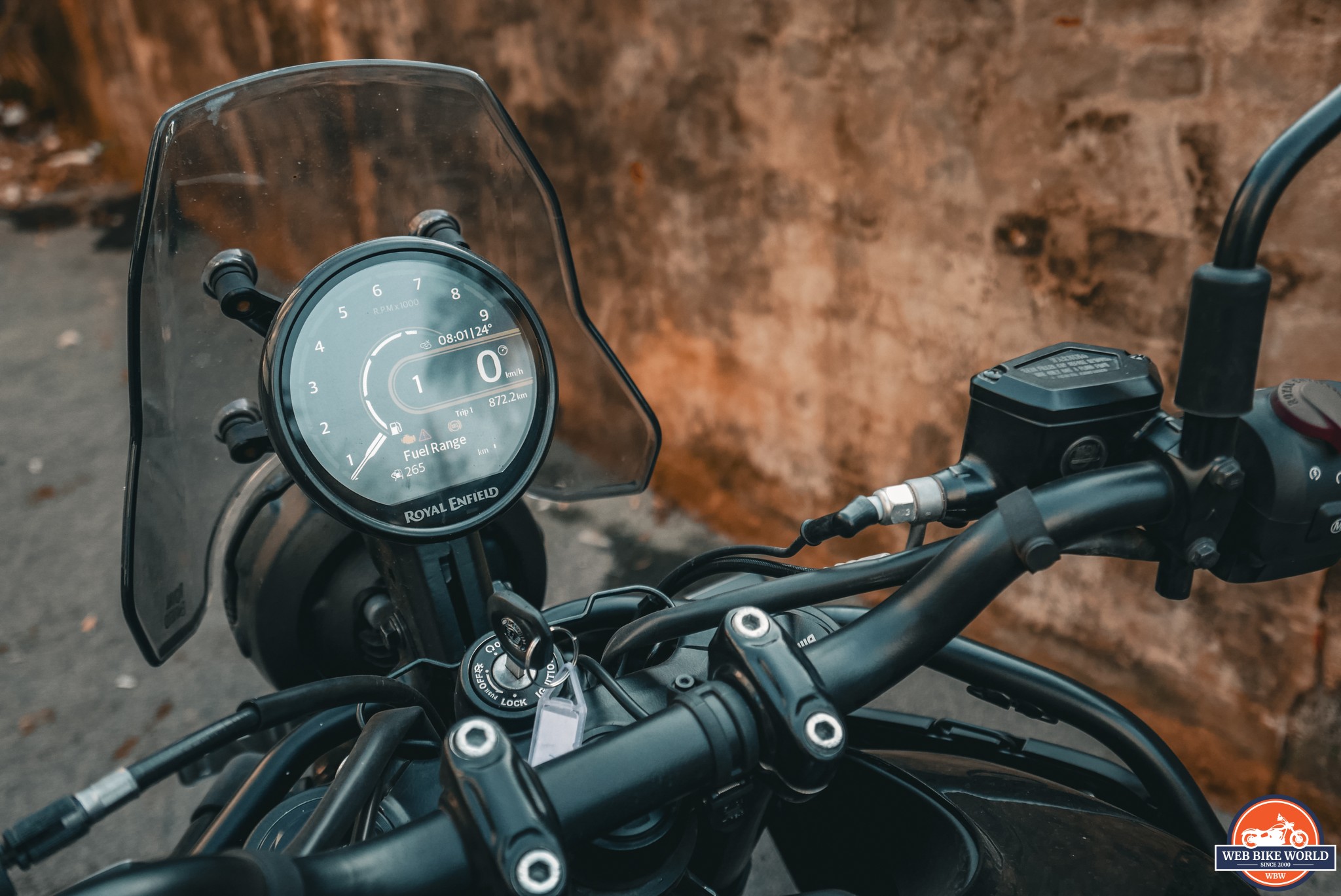
Electrics and Lighting
The Himalayan 450s premium feel is due in part to its modern electrics. A large 4-inch TFT ‘Tripper’ digital dash takes pride in place between the handlebars. The unit is jam-packed with standard and selectable information. The standard display includes RPM, a digital speedo, fuel capacity, a trip meter, a gear indicator, temperature, and time. Using a joystick beside the left grip allows you to access additional information. When you do this a smooth animation reorganizes everything to the lower half of the screen. This creates space to then display everything from battery voltage to service interval information.
The clever dash is also Bluetooth enabled which allows you to connect a mobile device. Once connected you can receive navigation instructions on the screen in the form of directional prompts or display a full Google Maps road view that takes over the top two-thirds of the screen.
During my 2 days with the bike, I didn’t have enough time to fully wrap my head around all of the settings and display information since I just wanted to ride, but I did discover you could switch it from a white background to a dark one which suited my bike much better and did not degrade the screens legibility.
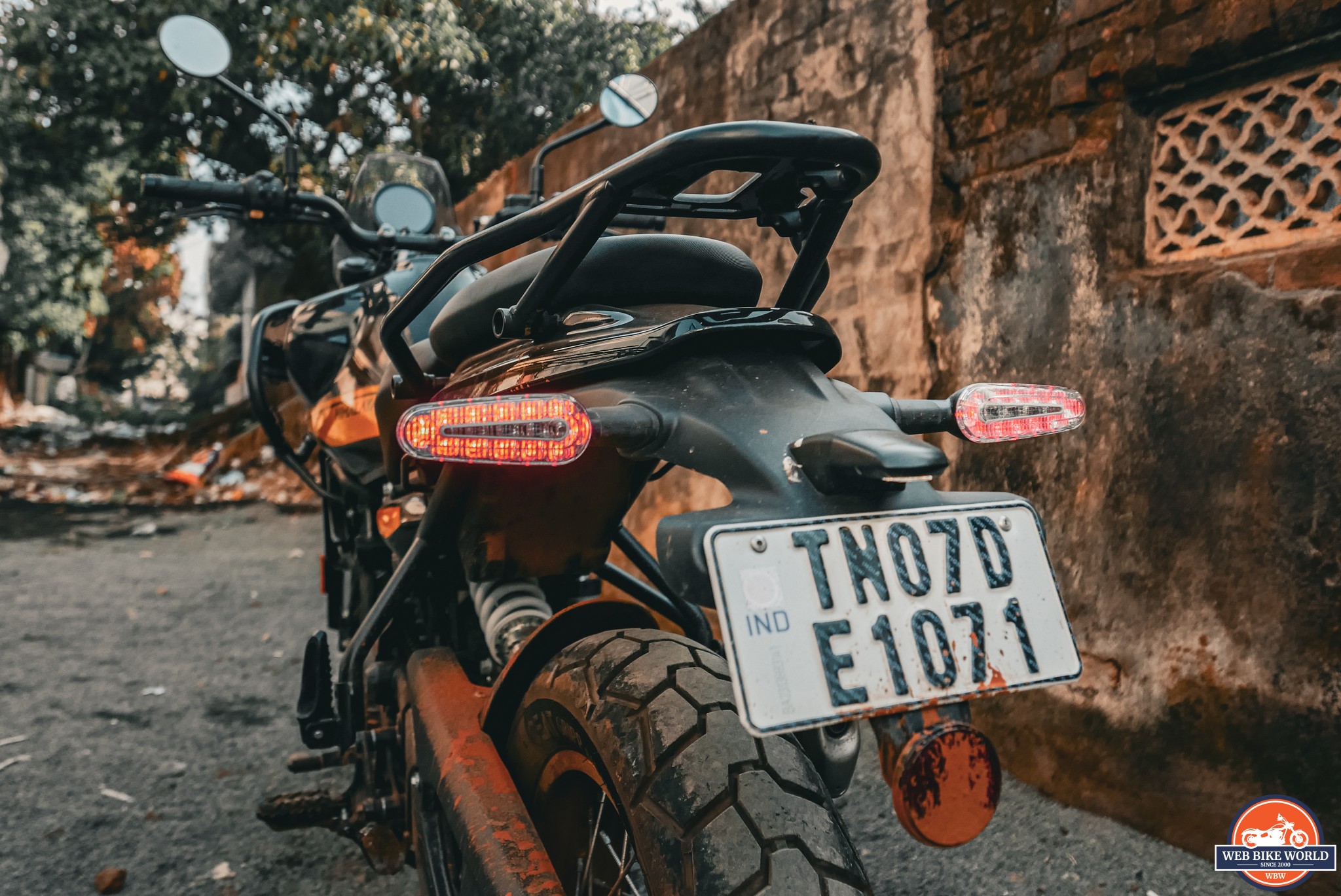
Additionally, the Himalayan 450 comes with a premium LED lighting package. At the pointy end of the bike sits a retro look headlamp sporting a Royal Enfield emblem across its center. The unit uses LED internals which omit a cool white light. The front turn signals are LED powered too as are the rear, but rather than fitting a bulky tail lamp Royal Enfield opted for dual-function turn signals.
The trick lights have a row of amber LEDs that function as turn signals. Around them is a halo of red LEDs that perform running and brake light duties. That may sound a bit gimmicky but they are actually highly visible and all of the riders in my group agreed that they were a stand-out design feature of the bike.
Other electronic gadgetry of the Himalayan 450 includes 2 rider modes of ECO or Performance, which alters throttle response as opposed to an actual change in power. You also get adjustable rear ABS that can be switched off easily with the press of a button and a handy USB-C charging point just below the TFT screen.
Plenty of buttons and switches to play with, but it all feels very intuitive.
Other Himalayan 450 Accessories and Features
On top of everything I’ve already covered the Himalayan 450 also comes with some decent accessories straight out of the box. Along with the radiator guard, you’ll find a bash plate covering the engine and exhaust.
There’s also a crash bar surrounding the fuel tank and a rack at the rear of the bike which would set you back a fair few dollars if you had to buy them aftermarket. The footpegs are nice and wide and their rubber inserts can be removed for added grip when you leave the tarmac.
The bike’s suspension consists of beefy 43mm USD forks in the front and a monoshock at the rear. During my ride, I didn’t have any issues with them, but those considering loading this bike up and heading on an adventure may want to do some upgrades. The brakes also do a good job even though there’s a single disc up front and as per homologation laws the bike is running ABS.
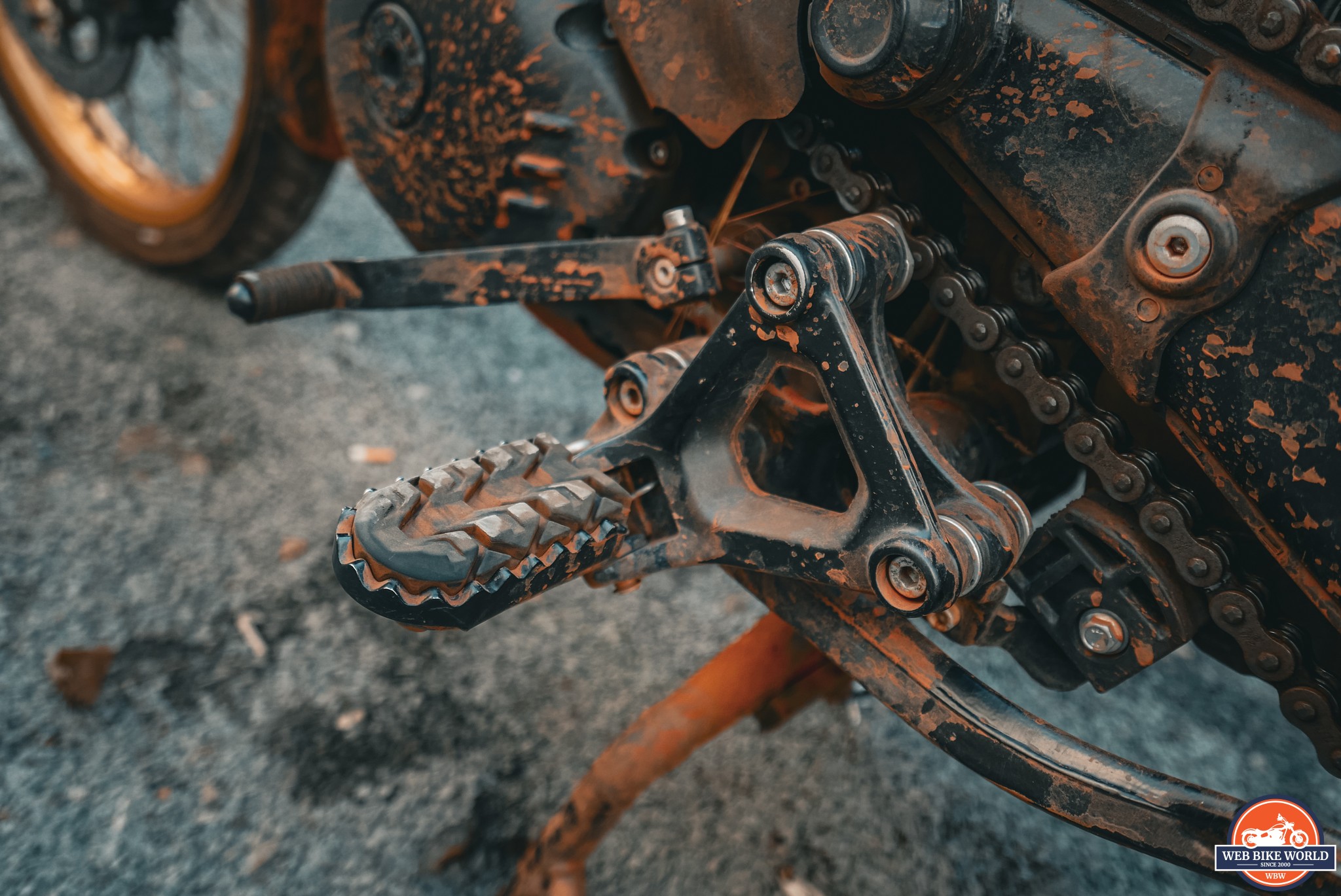
The tires on the Enfield’s 19-inch front and 17-inch rear rims are produced by Indian manufacturer CEAT. From what I could tell they have been produced specifically for this bike in collaboration with Royal Enfield. The dual-purpose tread pattern felt stable on sealed roads and did a decent job of keeping things manageable when we ventured onto loose surfaces.
One other interesting feature of this bike is that the seat height is adjustable. We discovered this by accident when needed a tool to tighten a loose mirror. This led to all of us moving the seat to the higher setting which ultimately resulted in a more comfortable ride.
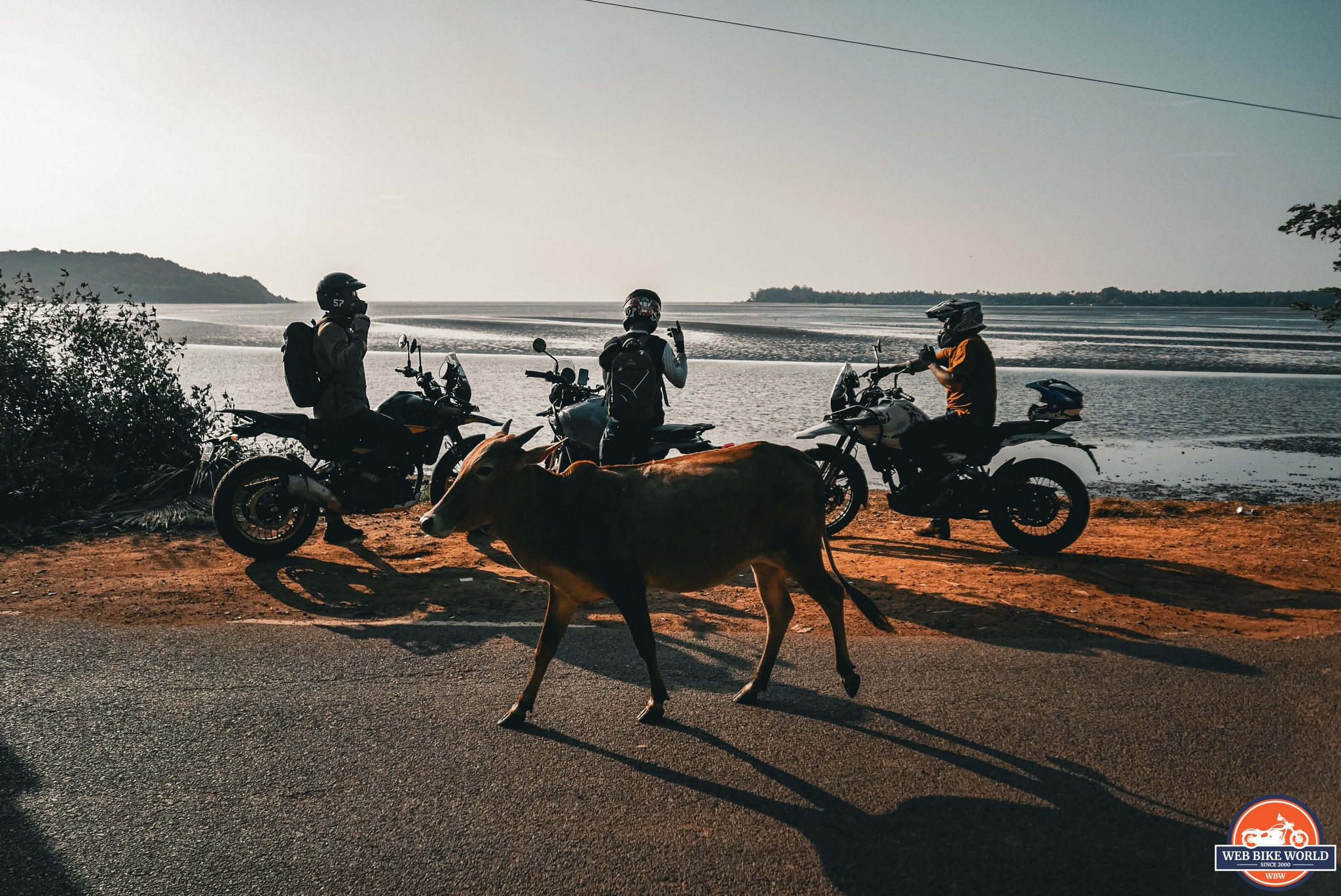
Riding The Himalayan 450 In The Real World.
Royal Enfield chose the Himalayas as a proving ground for this motorcycle. While that is of course impressive, many of the Himalayan 450s they sell will never be subjected to such use. We certainly weren’t about to embark on such a journey, but our ride was no walk in the park. In fact I’d say it was about as real-world as a test ride can get.
Riding the streets of India is unlike any riding you’ve done before. In towns and cities, the streets are constantly congested, and seemingly no road rules. At any time you can expect to see someone driving the wrong way down your lane or pulling in front of oncoming traffic without hesitation to make their turn.
If that’s not enough you also have to contend with trucks and buses who use their size to do as they please, wild dogs are crossing the street without warning, cows literally sleeping in the middle of the street and most roads are in various states of disrepair. A lack of concentration is here is ill-advised.
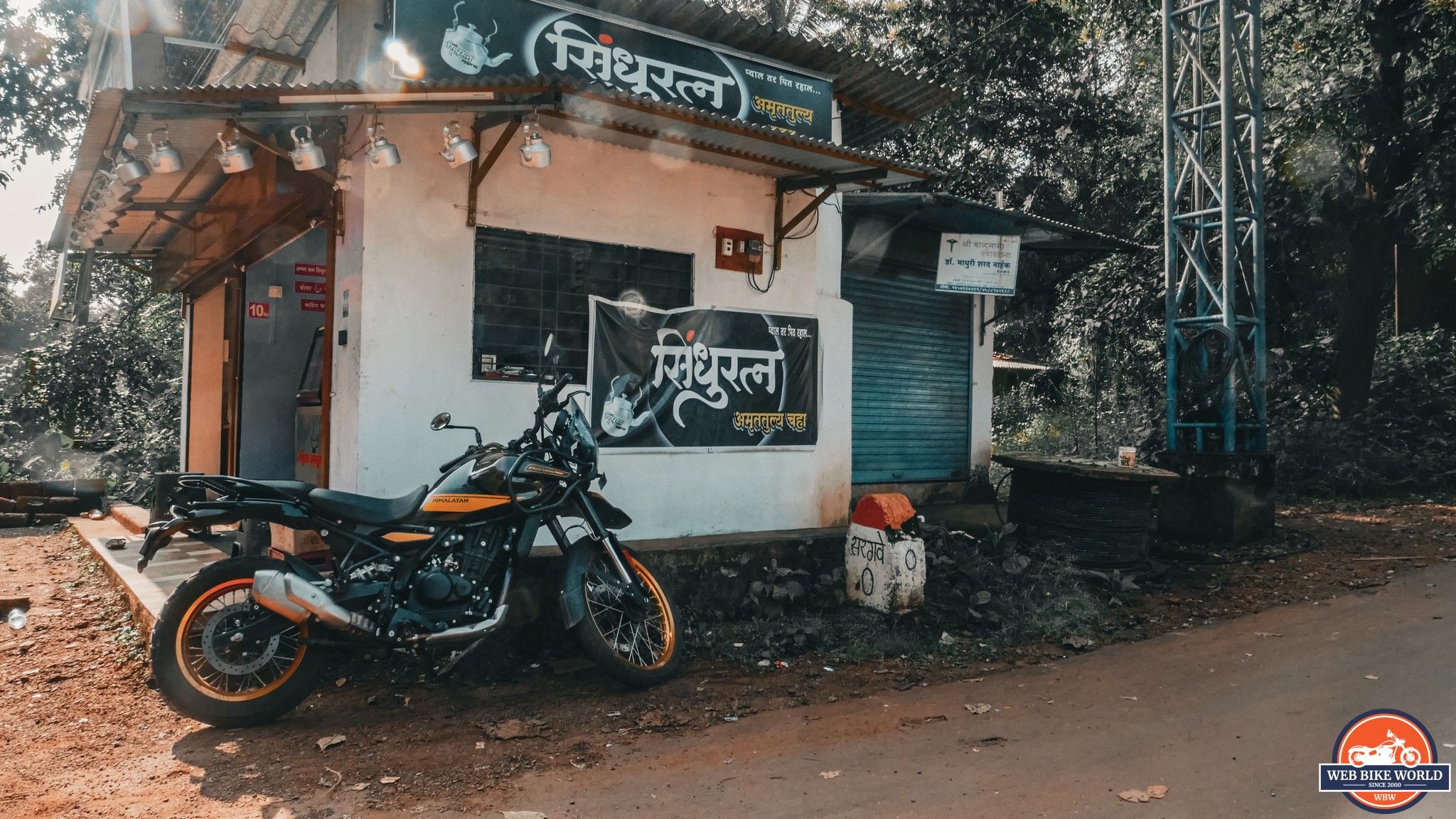
On day 1 we set off at around noon. Our destination was a mere 117km away but we didn’t arrive there until 6 hours later. A good chunk of that time was spent getting out of the densely populated coastal region of Goa. Despite feeling heavy at first the Himalayan 450 proved very agile at low speeds and we did a lot of slow-paced maneuvering to get through the chaotic traffic.
That doesn’t sound like much fun, but sitting high in the saddle of the Himalayan 450 and with enough get up and go to outpace most of the other vehicles on the road, it was a novel experience. You’ll also come across a lot of speed humps in India, many of which are not marked.
For most of the other traffic, slowed things down, but for us, they became a source of entertainment as we strived to see who could get the most air on our agile Himalayans.
Around 1.5 hours into the ride we made it out of the city and the traffic finally eased up. This was when the bikes proved they were capable of cruising at higher speeds. At that point, I realized I hadn’t used any gears above third so far so slipping it into fourth and then fifth felt very satisfying. I only saw 100 come up on the speedo a handful of times, but when it did the engine felt like it still had plenty to offer.
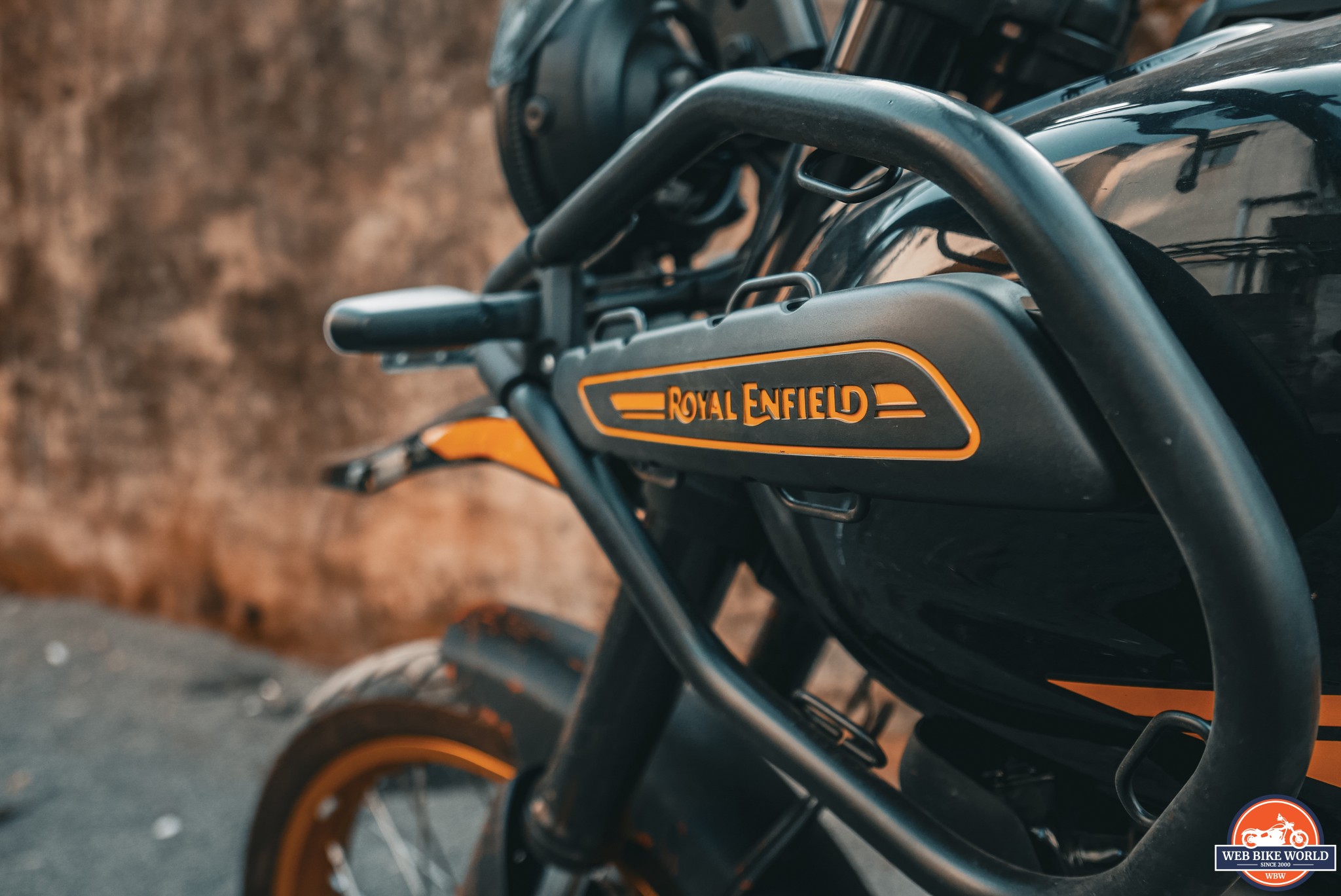
Three hours into our ride we began our ascent up to Tilari Nagar. The road was steep, filled with hairpins, and barely wide enough to fit 2 mid-sized cars. This is where we gave the tires, brakes, and gearbox a really good workout and once again, the bike faired well. When we reached the peak we were all smiles and decided to stop for a drink and discuss our accommodation options.
Everywhere we stopped locals approached us to talk about the bikes and ask where we were from. They all knew the bikes and were excited to see them in the flesh. At Tilari Nagar we met one particularly excited rider who was on an air-cooled Himalayan. After a short interaction, he offered to lead the way to Belgavi and we gladly accepted.
As the sun was setting we raced against the clock to make it to town before dark. Riding these streets at night was not something any of us wanted to do. Thankfully we arrived just after the sun had set, found a hotel, and settled down for a curry at a restaurant with our new friend
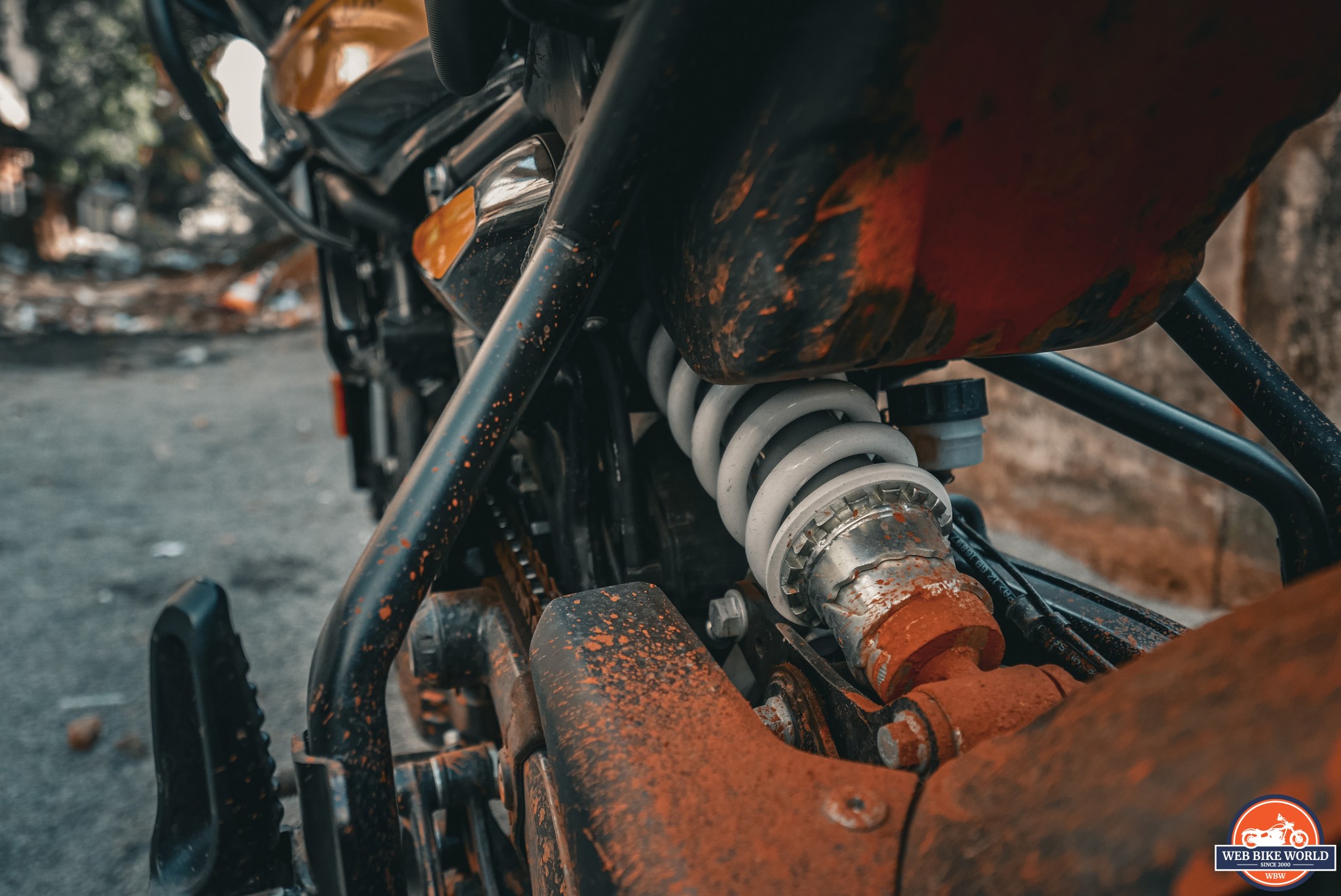
Day 2 began with a buffet breakfast and a visit to a thousand-year-old temple. From there we weaved our way out of the city again towards Kankumbi where another long winding road awaited us. We had been warned that this road would be slow going due to poor maintenance, but we laughed it off saying we were on Himalayans. Jokes aside, I’m really glad we were.
As we entered an Elephant and Tiger reserve the road dropped beneath a dense canopy of trees. Monkeys played on the roadside, shrieking at us as we rode by, and the potholes were soon big enough to tear the wheel off a car. We completed a large portion of this ride standing on our bikes pegs. I’m no adventure rider so this isn’t something I am used to doing, but the Himalayan was very forgiving.
Changing gears and braking while standing felt natural and the bars were just the right height to keep me comfortable all the while. Due to how bad this road was we all hit some pretty nasty bumps and the bikes admirably took it all in their stride.
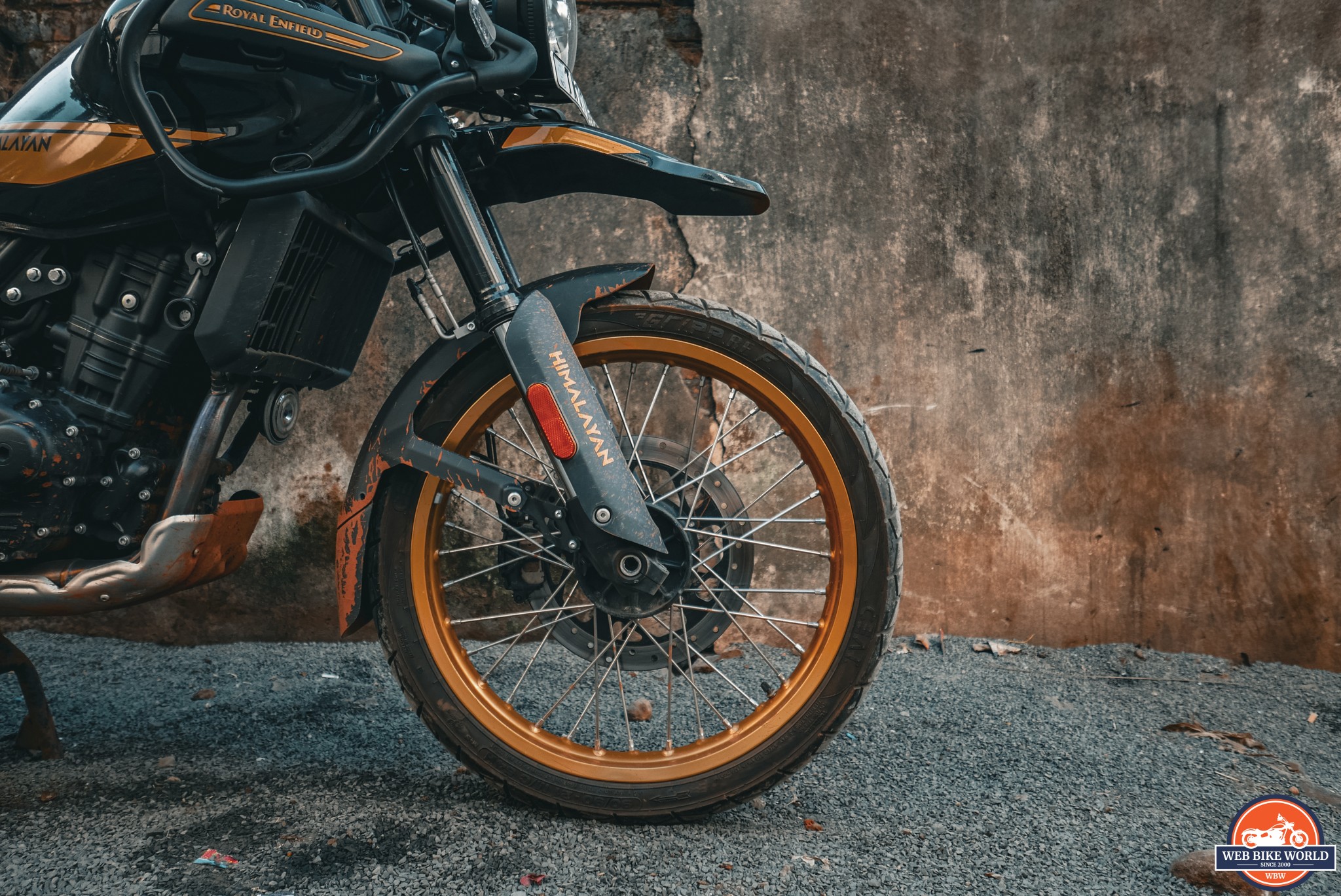
After coming out of the jungle we descended back down towards the coast on yet another tight winding road. This once again proved to be very entertaining and reminded me of the saying “It’s more fun to ride a slow bike fast”. That’s not to say that the Himalayan 450 is a particularly slow motorcycle, but if I’m comparing it to my Z900RS it is.
However, I’d never drive my Z like I did the Himalayan because I’d probably come unstuck. The Himalayan is a capable and very forgiving motorcycle that will allow even the most inexperienced rider to tackle unsavory road conditions with vigor. It may not be the fastest or the most powerful in its class, but it certainly is no less capable and a lot of fun to ride.
We ended our ride at a beachside bar where we all agreed that the Himalayan’s had won us over. Whether it was a combination of the environment, the company, or simply because the Himalayan 450 is a really good bike it doesn’t matter. I went home knowing I’d had an experience I would never forget and I have my riding companions and that black and gold Himalayan 450 to thank for it.
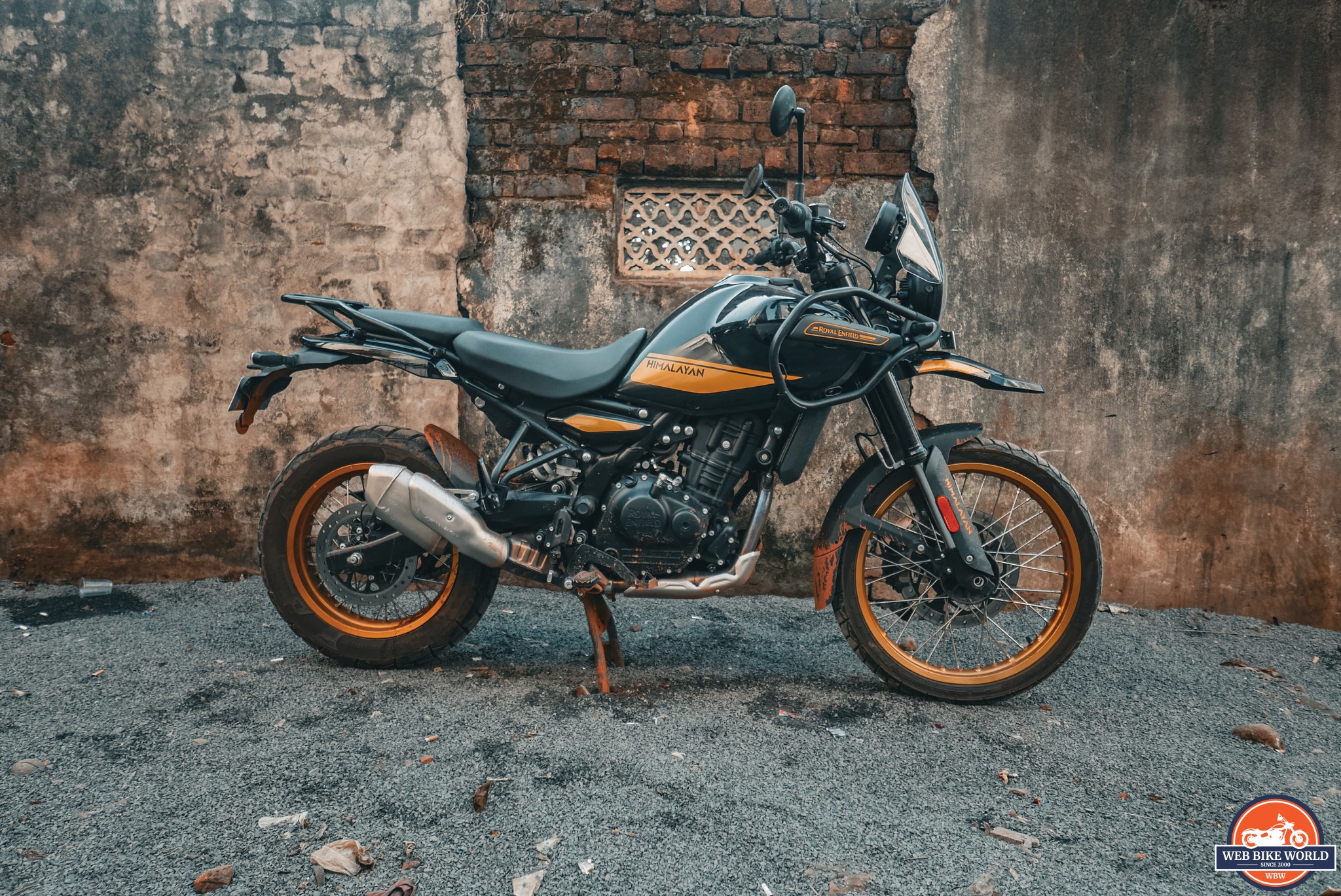
Cons
- Engine sounds a bit agricultural at low revs
- Seat height needs adjusting to be more comfortable
- Bit slow off the line if you haven’t wound the engine up a bit
- Need to get the revs up to enjoy what the engine has to offer
Pros
- Excellent value for money
- New engine is an all-round great performer
- Premium electrical components
- Good mileage from the 17-litre tank (approx 350km)
- Well-balanced and nimble
- It’s a hoot to ride hard
